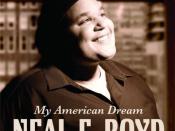Some writers believe that cultural artifacts can be used as a way of demonstrating the culture that they have come from. This is a wonderful concept, however some of these writers such as Scholes and DuCille take it a bit too far in what is a cultural artifact and why it represents our culture. Scholes uses the case of a Budweiser commercial to show that even visual texts such as commercials have a sense of culture to them. DuCille talks about how Barbie dolls give a false image of cultures. How much do cultural artifacts actually represent the way a culture truly is? DuCille and Scholes would probably agree that cultural artifacts do have some meaning to cultural development and representation, and I would agree as well, to a point. It is not the case that all cultural artifacts have the same relevance and that some are very poor examples to use in talking about the culture of a certain group.
In analyzing the Budweiser commercial Scholes mentions an American dream, ÃÂIt is the myth of America itself, of the racial melting pot, of upward mobility, of justice done without fear or favorÃÂ (372). Scholes is claiming that the American dream is one in which diverse people all get along, people strive and succeed in making their way up the corporate ladder, and people donÃÂt have to worry because justice will always prevail. This is a great dream, however I donÃÂt believe that the ÃÂAmericanÃÂ dream has always been this dream, or that it remains this dream. First we take a look at the first Americans, they were diverse in religion, however most were white unless they were slaves, they didnÃÂt seek to have total diversity or a melting pot, they only were seeking their own freedom. This example shows that Scholes has a false view of the American dream, or at least that he doesnÃÂt interpret it as an ever changing ideal like it truly is. This shows that evaluating a cultural artifact as being culturally important depends on your view of what that culture stands for or believes in, if you believe that the American dream is what Scholes says it is, then yes the Budweiser ad is a great cultural artifact. However you can interpret the American dream in other ways such as wanting freedom above all else and it doesnÃÂt apply to the commercial anymore making it less valid in defining our culture.
This brings up the point of a changing narrative. The narrative that people bring in when observing an artifact varies by which time period and what place they grew up in. The Budweiser commercial assumes that you come in with the narrative of what baseball is and how American society worked at that time. By assuming this many aspects of culture that the ad is trying to show can only be seen if you have those narratives to project onto the ad.
A cultural artifacts validity in representing the culture as a whole depends on the interpreter and the narratives that they bring to the playing field, so the case that all cultural artifacts represent a culture is already false. However are all cultural artifacts poorly expressing culture? Anne DuCille uses Barbie as an example of a cultural artifact. When talking about Shani, the African American Barbie, she says, ÃÂsales of black Barbie dolls reportedly doubled in the year following this new ethnically-oriented ad campaignÃÂ (463). Her point in this statement is that by trying to make Barbies represent multiple cultures MattelÃÂs sales almost doubled. This clearly shows that large corporations use culture as a method of selling. They target specific audiences that arenÃÂt already buying their products to increase profit. This seems like more of an exploit of culture rather than an expression of culture. Later DuCille talks about these dolls attributes in detail, ÃÂIt is after all the taste of consumers that is inscribed in BarbieÃÂs long, combable hairÃÂ (496). DuCille is pointing out that Barbie has long hair because it is a feature that sells better than short hair. She makes this point because all Barbies have long hair no matter which ethnicity they represent, even though some ethnicities cannot really grow that long of hair. She has a very good point here. Companies are altering how the culture really is in order to sell more. If they are altering aspects of the culture in the artifacts representation then they are not accurately portraying what they should be. This is only one example that advertisements and products such as toys are poor examples of cultural artifacts, the companies will change the truth of the culture to what they have discovered is more likely to sell, thus providing a false depiction of the culture they would like you to think they are representing.
Hope of cultural artifacts providing realistic cultural representation is dwindling. The Wizard of Oz is a good example of expressing cultural beliefs in the film medium. There are multiple interpretations of the Wizard of Oz. Some people see it as a coming of age story, some may see it for that simple one liner ÃÂthereÃÂs no place like homeÃÂ, some may see it as a story of friendship and some may be very creative and see it as a metaphor for the election of 1986. All of these different views all express the culture that the Americans that made it have. The majority of Americans enjoy friends, enjoy their home, and nobody can deny that the election of 1986 occurred. This leads me to believe that film is one of the most reliable representations of culture. The main concern now is what part of the film industry makes movies more likely to be viable cultural artifacts than other artifacts. What does it have that dolls and commercials donÃÂt have?These artifacts are more likely to express culture as it truly is because of their ingrained story or narrative. Scholes argues that commercials do have a story when he states, ÃÂIn processing a narrative text we actually construct the story, bringing a vast repertory of cultural knowledge to bear upon the text that we are contemplatingÃÂ (372). Scholes is saying that by taking knowledge we have gained through experience and what information the commercial gives us that it has a story. That is a good point, however not everyone has the experiences needed to make the story. So as stated before, the validity of using a commercial as a cultural artifact depends on the interpretation or experiences of the person. So commercials can be viable cultural artifacts sometimes and for some people, and it sometimes has a story, so this story route seems to be a valid explanation for what can make an artifact cultural representative. Does Barbie have a story? It doesnÃÂt appear that she does, the closest to a story she seems to have is your story, ÃÂBarbie allows little girls to dreamÃÂ (463). DuCille uses this quote from Deborah Mitchell to make her point that little girls need dolls that are similar to them so they can dream about themselves. If Barbie allows girls to dream then itÃÂs as though they are creating her story through their own experiences and not BarbieÃÂs experiences, seeing as how sheÃÂs a doll she canÃÂt have any. The girls are projecting the narrative of their own lives onto the doll which makes it more appealing, but also makes Barbie not represent the culture that she is supposed to represent. So Barbie lacks a story, this supports the claim that a story helps an artifact to make for better cultural artifacts.
The other main type of artifact with a story is the novel. An example of this would be the graphic novel Watchmen. In this graphic novel the story is what would have happened if there were superheroes during important historical moments in United States history. Not only does this have a story that supports culture in the United States by showing such things as patriotism, love of comics, and love, but it also has historical background. By using historical events and information there is an undeniable fact that the text is a good representation of culture. History after all is the past of a culture, and one of the best ways to learn about a culture is to learn about its past.
It seems that having to project your own narrative into something makes a cultural artifact less reliable, it makes it be whatever you want it to be, not what the culture actually is. If the narrative is already in the story then it is much harder to change and project your own narrative on it, which allows it to more accurately represent the culture.
So cultural artifacts vary on their value in telling someone about the culture they represent. Some artifacts have no value, some have value depending on how you interpret it, and artifacts that have a story or history in it are more likely to be more representative of the culture. Along with this the types of artifacts that Scholes and DuCille reference all have to do with selling something, and these two artifacts were less reliable than other ones I referenced. This shows that when money is involved the cultural significance of the artifact decreases. So if looking for culture in every day things try to avoid things that sell and try to avoid projecting your own narratives onto it.
Bibliography:"Artifact (archaeology)." Wikipedia, The Free Encyclopedia. 20 Oct 2009, 08:57 UTC. 22 Oct 2009 .





